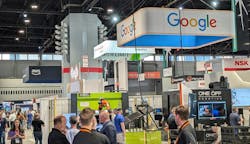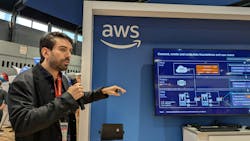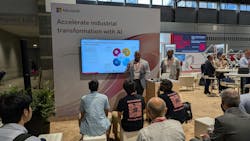IMTS Day 2: Big Tech Says ‘We Love Manufacturing’
Walk through the South Hall of McCormick Place in Chicago during IMTS – The International Manufacturing Technology Show, and little looks different from past years. The big iron is on display – massive vertical and horizontal machining centers designed to carve metal parts out of steel bars and blocks in seconds.
Turn around, and the story’s a bit different. Nestled between companies offering metal linear guideways and material flow management or robotic welding systems are some familiar names – Google, Microsoft, Amazon (well, AWS formerly Amazon Web Services). While each booth is different, the messages are remarkably similar.
Collect all of the data that you can from manufacturing systems. Send those data to the cloud. Get incredible insights from data analytics to make your business even better.
An issue, brought up by several show attendees, is that first step of data collection. In theory, most machines can feed data to various systems, enabling those big data-driven insights. In practice, overworked operational technology (OT) departments become responsible for installing and maintaining data-collection systems. And because OT’s job is keeping manufacturing equipment running, secondary systems like data loggers become a secondary priority at best.
Francisco Javier Franco Espinoza, a strategy and innovations manager for Siemens Factory Automation (speaking at AWS’ booth) says it’s a fair complaint. While the industry talks about OT merging with information technology, those job functions remain completely distinct from each other – OT in charge of keeping the factory humming, IT in charge of the computer pieces that handle the rest.
“IT-OT convergence isn’t happening for job titles. We still have IT and OT,” Espinoza says. “True convergence is in the systems. We have to make systems that are easily usable for OT but support the big IT initiatives.”
So, while AWS and Google both offered sessions about IT-OT convergence, a better way to look at things is that systems can be good doorways that keep OT people performing their vital functions on one side of the wall while IT people do something completely different. So, not so much convergence as improved co-existence.
The presence of the big tech companies at the show was a popular conversation topic for show-goers. One visitor told me that he and a lot of his colleagues at a small manufacturing company in Texas are interested in what artificial intelligence could do for them, so they had meetings scheduled with Google and Microsoft.
About the Author
Robert Schoenberger
Editor-in-Chief
LinkedIn: linkedin.com/in/robert-schoenberger-4326b810
Bio: Robert Schoenberger has been writing about manufacturing technology in one form or another since the late 1990s. He began his career in newspapers in South Texas and has worked for The Clarion-Ledger in Jackson, Mississippi; The Courier-Journal in Louisville, Kentucky; and The Plain Dealer in Cleveland where he spent more than six years as the automotive reporter. In 2014, he launched Today's Motor Vehicles (now EV Manufacturing & Design), a magazine focusing on design and manufacturing topics within the automotive and commercial truck worlds. He joined IndustryWeek in late 2021.



